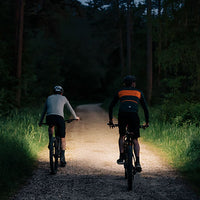40 Bikepacking Tips to Prepare for the Unexpected

Wendy
Jan. 23, 2025
Jan. 23, 2025
Bikepacking is an incredible way to explore the outdoors. However, it comes with challenges. The best adventures come with a bit of unpredictability, so preparation is key. Whether you're tackling rugged trails or open roads, these tips will prepare you for whatever comes your way.



Bike Repair
Let's face it: something will probably go wrong with your bike on a long trip. A flat tire, a loose chain, or a wobbly seat can turn a fantastic day into a frustrating one. Here are some essential bike repair tips:
1. Learn Basic Repairs
Practice fixing a flat, adjusting brakes, and tightening a chain before your trip. Watching a few online tutorials can also help build your confidence.
2. Check Your Gear
Make sure your multi-tool has all the necessary components, like Allen wrenches and a chain breaker.
3. Pack Extra Tubes
Bring at least two spare tubes and a patch kit. A tubeless tire sealant is also handy if you want to pack light.
4. Use Tire Liners
Tire liners can prevent flats from sharp objects like thorns or glass.
5. Carry Duct Tape and Zip Ties
They're versatile and can quickly fix ripped bags, broken mounts, or loose gear.



Weather Preparedness
Weather changes fast, especially in remote areas. Being unprepared can make your trip miserable or even dangerous. Follow these weather preparedness tips for a smoother bikepacking trip:
6. Layer Smart
Wear a moisture-wicking base layer, an insulating middle layer, and a waterproof outer layer. This combination keeps you comfortable in various conditions.
7. Pack Rain Gear
A lightweight rain jacket and waterproof pants are must-haves that keep you dry.
8. Protect Your Electronics
Use waterproof bags or zip locks for your phone, GPS device, and battery packs.
9. Bring Gloves
Insulated gloves can prevent cold, stiff hands, which are nightmares when riding.
10. Watch the Skies
Check forecasts frequently and plan for sudden changes. Be flexible with your cycling route if storms are likely to happen.

Staying Hydrated and Nourished
Bikepacking burns serious calories, and you'll sweat more than you think. Avoid dehydration or running out of energy with these tips:
11. Drink Regularly
Sip water every 15 to 20 minutes, even if you're not thirsty. Remember to stay ahead of dehydration.


12. Use a Hydration Pack
They're convenient and let you carry more water without frequent refills.
13. Plan Water Stops
They're convenient and let you carry more water without frequent refills.
14. Bring Snacks
Pack high-energy foods like jerky, energy bars, peanut butter, and dried fruits. They're compact and provide quick fuel.
15. Add Electrolytes
Bring electrolyte tablets or powders to replenish lost salts and avoid cramping.
16. Test your food.
Try your snacks and hydration strategies on shorter rides before your trip to see what works for you.

Medication for Injuries
Accidents can happen, even on well-planned trips. Here are some medication tips:
17. Bring Painkillers
Bring ibuprofen or acetaminophen for aches, swelling, or injuries.
18. Pack for Wound Care
Pack adhesive bandages, gauze, and antiseptic wipes to clean and protect cuts.
19. Add Blister Treatment
Are you going to hike or push your bike? Bring moleskin and blister pads.
20. Be Prepared for Allergies
Antihistamines can help with unexpected allergic reactions to plants, insects, or food.
21. Bring Tweezers and Scissors
Use them for splinters, ticks, or cutting bandages.
22. Pack an Emergency Whistle
Bring an emergency whistle to call for help in remote areas.



Wildlife Safety
Encounters with wildlife can be exciting. But they can be dangerous if you're not careful. Respect the animals and protect yourself with these tips:
23. Make Noise
Clap, ring a bell, or talk to alert animals to your presence, especially in dense forests.
24. Store Food Safely
Use bear-proof containers or hang your food at least 10 feet off the ground and away from your campsite.
25. Carry Bear Spray
This is a must if you're backpacking in areas with bears. You can also bring this even if you're not in bear-prone areas for extra protection against other animals.
26. Stay Alert
Watch for animal tracks, scat, or other signs of recent wildlife activity.
27. Travel in Groups if Possible
Bigger groups are less likely to be approached by wildlife, so travel with others if possible.
28. Keep Your Distance
Never approach or feed wild animals. It's safer for you and better for them.

Gear Up for Night Rides
Night rides can be magical, but they're also risky if you're not prepared. Visibility and safety are the name of the game. Here are the best night ride tips for bikepackers:


29. Use Powerful Bike Lights
Use a bright front bike light (at least 500 lumens) and a flashing rear bike light to make sure you can see and be seen. For instance, the ALLTY 2500S Bicycle Light has a maximum output of 2,500 lumens. The SEEMEE 50 V2.0 Smart Tail Light is also bright enough but not blinding.
30. Use Helmet Lights
These are perfect for illuminating trails, reading maps, or spotting obstacles in the dark. The MONTEER 8000S GALAXY V2.0 Remote MTB Light has a maximum 8,000-lumen output and 32 hours of running time.
31. Wear Reflective Clothing
Add reflective tape, patches, or gear to increase visibility.
32. Carry Extra Batteries or Power Banks
33. Stick to Familiar Routes
Exploring new areas at night can be disorienting and unsafe.
34. Set up Camp Early
Set up your campsite before sunset if you're uncomfortable riding in the dark.

Navigating Without Getting Lost
Getting lost is a quick way to turn a fun adventure into a stressful one. Avoid it with these tips:
35. Bring a Physical Map
It's a reliable backup if your electronics fail or your GPS dies.
36. Mark Waypoints
Mark key points, such as water sources, campsites, or turns, with a GPS device, app, or pen and paper.
37. Learn to Read a Compass
Basic navigation skills can be a lifesaver if your tech fails.
38. Check in Regularly
Basic navigation skills can be a lifesaver if your tech fails.
39. Stay on Marked Trails
Going off-course can lead to getting lost or encountering unexpected hazards.
40. Use Route Planning APPs
Route planning apps can help you map your path and track your progress.



Conclusion
Bikepacking is about adventure, but being prepared prevents the unexpected from ruining your trip. Pack the right tools, dress for the weather, stay fueled, and know how to handle emergencies. With enough preparation, you'll spend less time stressing and more time enjoying the ride. Happy bikepacking!




0 comments